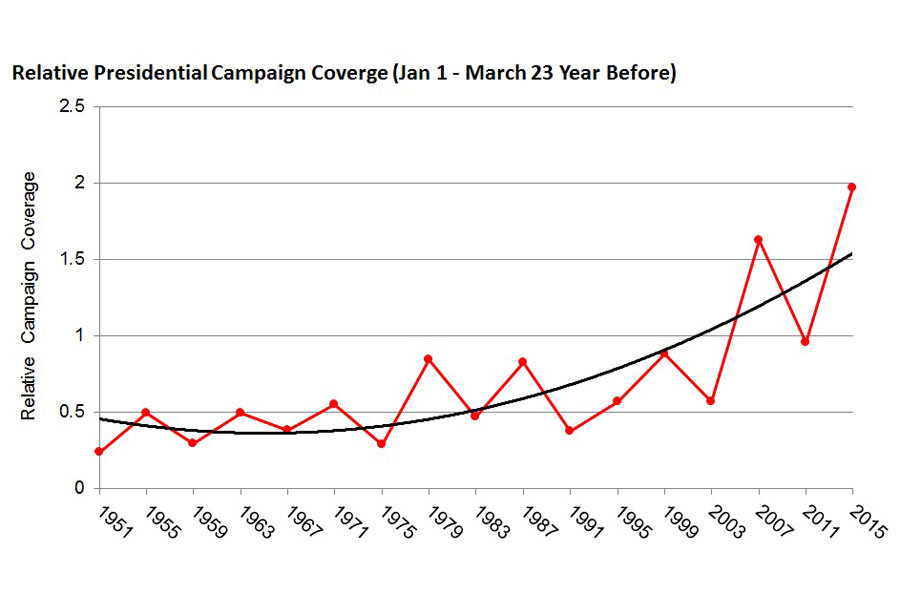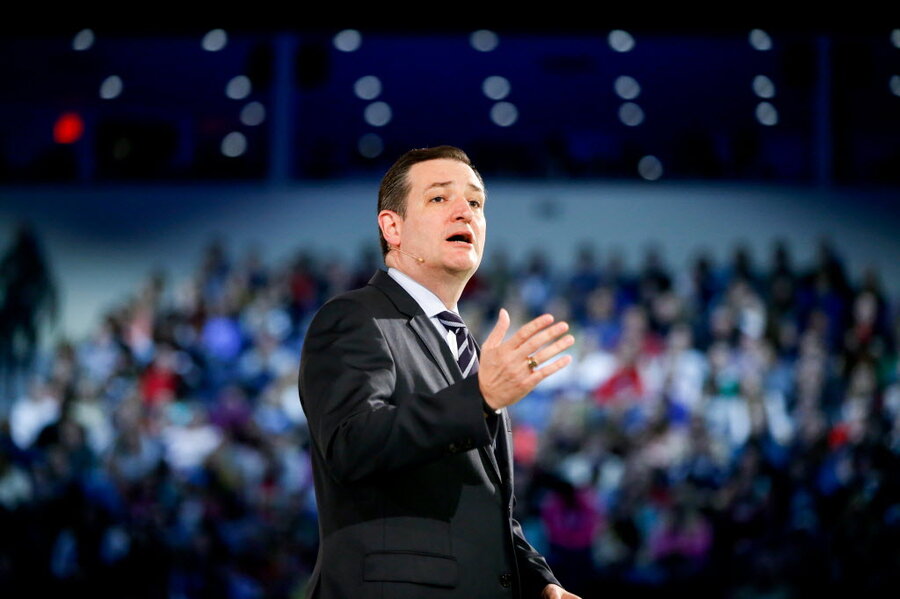The curious thing about how the media is covering Ted Cruz
Loading...
Like a bugle at the start of a horse race, Sen. Ted Cruz’s announcement Monday signals the beginning of the 2016 presidential election.
Indeed, in the American political lexicon the term “horse race” refers to the media’s obsession with electoral prognostication. Even casual observers know that political gamesmanship will be the prevailing narrative from now until November 2016. Cue the endless discussion of “who’s up, who’s down” in a given day, week, or month.
If you think the media’s obsession with the so-called horse race has grown in recent elections, you get a cookie. According to one study, for example, the media’s focus on presidential campaigns (as opposed to the candidates’ issue positions or background) nearly doubled from the 1960s to the 1990s. It’s hard to overstate, but elections weren’t always like this.
2008 was a watershed moment in this horse race obsession. For example, according to an analysis by Pew and Harvard University, in 2008 63 percent of campaign stories focused on “political and tactical aspects of the campaign” in stark contrast to just 15 percent that focused on the candidates’ policy views. It concluded:
This election is unprecedented in terms of its early start and how much early coverage it received. By February 2007, nearly 11 months before any citizen would cast a primary vote or gather for a caucus, the race became one of the biggest stories in the news.
Let that sink in for a moment. In 2007, nearly two years before the election was held, the media focused on campaigns, rather than actual issues, by a 4-to-1 margin.
All this begs the question: How is the 2016 horse race shaping up? (An alternative title for this post could be: “Let’s horse race the horse race.”)
On the one hand, it’s easy to juxtapose the start of two (or more) presidential campaigns: Simply compare when the candidates declared their intentions to run.
In the 2012 presidential election, for example, Newt Gingrich was first out of the gate, announcing his plans on May 11, 2011. So by that token, 2016 is beginning early.
In the 2008 campaign, however, then-Sen. Barack Obama announced his candidacy on Feb. 10, 2007, beating Senator Cruz by well over a month. Moreover, Senator Obama was late to the game. Hillary Clinton announced her intentions on Jan. 20, 2007; Biden entered the race on Jan. 7; and John Edwards announced his intentions on Dec. 26, 2006!
So, while it may “feel” like the 2016 campaign is starting earlier than normal, this is contradicted by the simple fact that in 2008, every major Democratic candidate had announced before Ted Cruz. On average, in fact, the major Democratic candidates announced more than two months earlier than Cruz.
Of course, official announcements can be a poor measure of the nature of campaigns and campaign coverage. For example, at present a half dozen major Republicans are in a nebulous “exploratory mode,” including Wisconsin Gov. Scott Walker, New Jersey Gov. Chris Christie, Sen. Rand Paul of Kentucky, Sen. Marco Rubio of Florida, and Jeb Bush. Living in South Carolina – with its “first in the South” primary – the 2016 campaign has clearly begun.
A more relevant metric is the volume of media coverage.
In the figure above, I report the volume of New York Times articles from Jan. 1 the year before the election (2015, 2011, 2007… 1951) to March 23 the same year (the date of Cruz’s announcement). I used two search terms (with Boolean operators) to quantify the volume of campaign coverage:
- presidential w/5 candidate
- president AND 2016 w/10 campaign
The first search returns stories where the word “presidential” appears in an article within five words of the term “candidate.” The second returns stories where the word “president” and the election year appear in an article within ten words of “campaign.” Both search terms produce estimates of campaign coverage that correlate at 0.70.
In the figure, the data represent the relative volume of campaign coverage from 1951 to 2015. Higher values indicate a greater volume of campaigning articles relative to the volume of all political news articles. (Details below.)
Despite the apparent “slow start” to the 2016 presidential race, we can see in the figure that the volume of campaign coverage is up 100 percent from this time in the 2012 cycle. Even when compared with the 2008 election – a watershed moment in the horse race – the volume of campaign coverage is up 25 percent. In the end, Americans are being inundated with more campaign coverage than ever!
In one important respect, the horse race is even worse than the raw numbers imply. Recall that in 2008, every major Democratic candidate (save John Edwards) announced between January and March of 2007. So, the media’s emphasis on presidential campaigns is up 25 percent from 2008 despite the fact that only one candidate has announced.
Additional findings
- We can see that the volume of campaign coverage has grown exponentially since the 1950s. If we compare the five presidential campaigns from 1951 to 1967 to the five campaigns from 1999 to 2015, the volume of campaign coverage is up 200 percent. If we restrict it to the first three and last three, campaign coverage is up almost 300 percent.
- 1980 was anomalous compared with the previous seven presidential elections, with campaign coverage in 1979 doubling the average in the previous seven cycles.
- As the Pew and Harvard study notes, 2008 seems to be the year when campaign coverage really spiked. We can see a modest increase between 1979 and 2003, but the single biggest election-to-election increase was from 2003 to 2007.
- Generally, elections featuring two non-incumbents (2008, 2000, etc.) generate greater early campaign coverage (though clear expectations exist, most notably 1980). Obviously, this is a reason why 2016 is shaping up to be a big cycle.
In conclusion, while Cruz’s announcement starts the horse race later than in 2008, the 2016 campaign is already more intense at the same point in time despite the absence of any candidates.
* * * * * * *
Methods: First, the number of stories containing each search term was compiled, divided by its average over the entire time series, and then added together in one summary index. Second, because the data spans the entire post-War period (from the 1952 campaign to 2016 campaign) it is important to account for the baseline level of political news coverage. For example, a higher volume of campaign stories in 2015 could reflect greater attention to politics in general compared to 1951.
In some respects, this also creates a baseline level of political news reporting. For this, I simply used the volume of stories containing the words “politics” or “congress.” I then created a “baseline” index in the same manner as the campaign index. Finally, I divided the campaign index from the baseline index such that higher values indicate a greater relative share of campaigning news stories. Note that the same results are evident we use the raw volume of campaigning new stories, without diving by the total number of political news stories.
If anything, the estimates reported in the figure are conservative.
* * * * * * *
Jordan Ragusa publishes his Rule 22 blog at http://rule22.wordpress.com.







